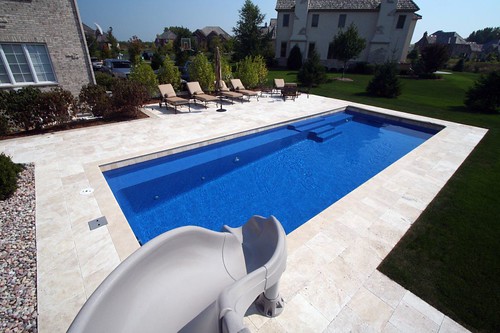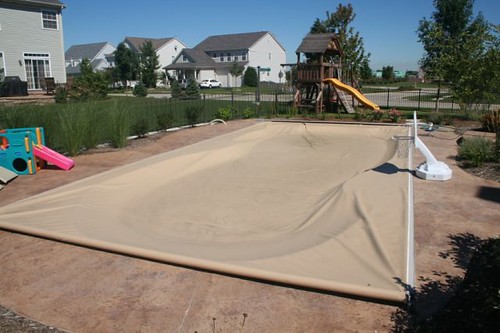
These three terms are all used to describe the same thing: natural chlorine generation using sodium chloride. As magical (or complicated) as this may sound this process of generating chlorine is just some basic chemistry put to work. Simply put, salt is added to swimming pool water and then broken into the two chemical compounds that make up the salt (sodium and chloride). The chloride is then released back into the water providing sanitation for the pool.
This process of breaking salt into its elements is commonly known as electrolysis. Inside the pool equipment is a ‘cell’ with several metal plates that are mildly charged with a positive and negative current. As the saltwater pass by the cell, the current causes a reaction to happen, breaking down the salt into its two chemical compounds (NaCl). The sodium is collected onto the plates, while the chloride is released back into the water.
This system of sanitation is a very popular alternative to the chlorine feeders of the past. Prior to the salt chlorination development, most people added chlorine tabs or ‘pucks’ to an in-line feeder in the pool equipment. As water flows past these pucks, they dissolve into the water providing chlorine to the pool. The disadvantage to this type of system is two fold:
- You must remember to ‘feed the pool’ chorine on a regular basis. Customers with this type of chlorine delivery system must refill the tabs ever week to maintain proper sanitation levels in the pool.
- You can taste, smell, and feel the chlorine. The reaction is exactly what you might expect- burning eyes, faded swimming suites, and the residual smell of chlorine on your skin once you get out of the water.
A chlorine generating salt systems does not have these problems. Chlorine is constantly being produced by the salt in the water and you only need to add salt once or twice a season. The only way to loose salt from the water is by adding fresh water to the pool. Salt cannot be “burnt off” by the sun like chlorine or otherwise evaporate over time. Only the addition of fresh water from rain or a garden hose will deplete the amount of salt in the pool. Secondly, because the chloride is produced in its natural state, there is no smell, taste, or feel of chlorine in the pool water. No more burning eyes or faded hair!
The only maintenance necessary on the salt cell is a cleaning every now and then. Just like the oil change reminder on many modern cars, the system tells you when it is time to clean the cell (typically once a month). Follow the simple instructions from the manufacturer for the cleaning procedure and you’re ready to get back to the pool!
If you have further questions about chlorine generators, feel free to contact Signature Pools and Spas at 630.845.1145 or visit us at: www.sigpoolschicago.mysites.io


